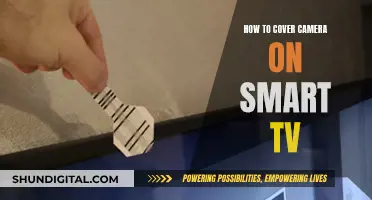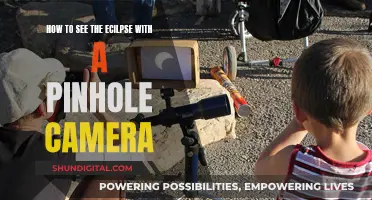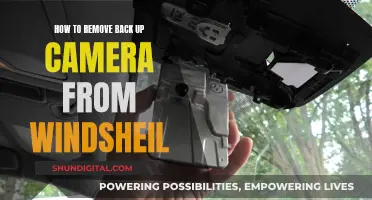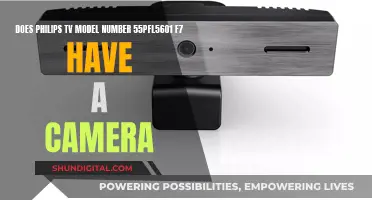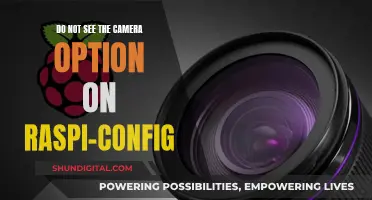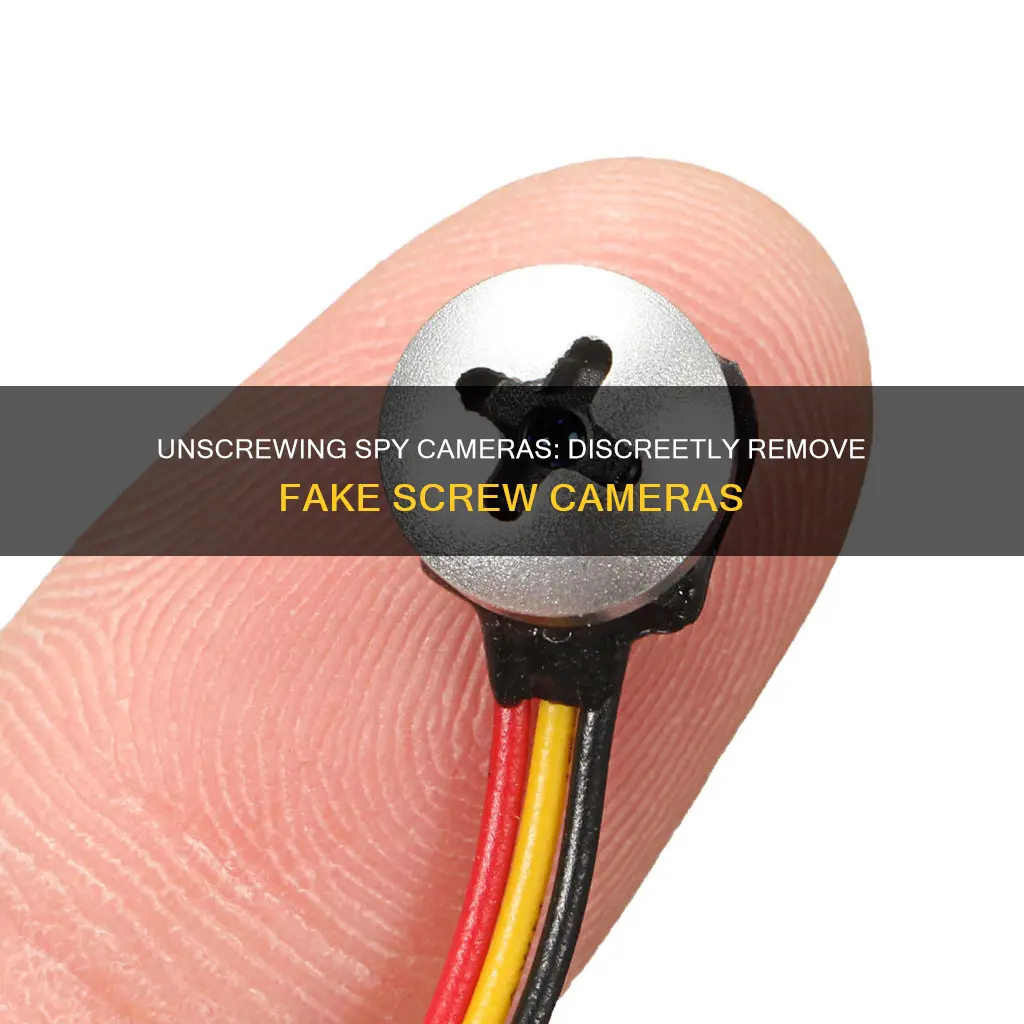
Hidden cameras are becoming increasingly common and can be disguised as everyday objects, such as screws. These fake screw cameras are easily available to buy online and can be installed in walls, furniture, or even a briefcase. They can be difficult to detect, but there are a few methods you can use to identify them. Once identified, you can take steps to disable the camera by covering its head with tape or calling a professional spy technician. Removing the screw camera can be challenging, but it is possible to do so without damaging the camera or the surrounding area. This may require special tools and a lot of patience.
| Characteristics | Values |
|---|---|
| Cost | $15-20 |
| Connection Types | USB ports, composite inputs, and CCTV systems |
| Camera Resolution | 330 TV lines |
| Camera Sensor | 1/3-inch colour advanced CMOS sensor |
| Detection Methods | Observe suspicious lights, lenses, wires, power sources, LEDs, sounds, and Wi-Fi connections; use a smartphone to check for glares; use a red LED detector; use a purpose-built RF detector |
| Removal Methods | Cover the camera with tape; use a flathead screwdriver; use a dremel; use a rubber band; drill out the screw |
What You'll Learn

Use a smartphone to check for glares or unidentified WiFi connections
Using a Smartphone to Check for Glares or Unidentified WiFi Connections
If you suspect that a fake screw spy camera has been installed somewhere in your home, one way to detect it is by using your smartphone. Here are some detailed instructions on how to do this:
Make the Room Dark
Turn off the lights in the room and draw the curtains to make the room as dark as possible. This step is important because it will make it easier to spot any suspicious lights or glares coming from hidden cameras.
Use Your Smartphone's Camera
Open the camera app on your smartphone and start scanning the room. Pay close attention to the camera's screen as you do this. Look for any unusual lights, glares, or reflections that could indicate the presence of a hidden camera. You can also try using the smartphone's flashlight to see if any reflective surfaces or lenses become visible.
Check for Unidentified WiFi Connections
Another way to use your smartphone to detect hidden cameras is by checking your WiFi network. Hidden cameras often connect to WiFi so they can be viewed remotely. Go to your WiFi settings and look for any unidentified devices or strange names connected to your network. These could indicate the presence of a hidden camera. You can also try using a WiFi scanning app, such as Fing, which can help you locate all the devices connected to your network, including hidden cameras.
Download a Hidden Camera Detector App
There are many hidden camera detector apps available for both iPhone and Android smartphones. These apps can help you detect hidden cameras by scanning for electromagnetic fields, light reflections, or infrared signals. Some popular apps include Glint Finder for Android and Hidden Camera Detector for iPhone.
Test Your Smartphone's Camera
Before you start scanning for hidden cameras, it's a good idea to test your smartphone's camera to make sure it can detect infrared light. You can do this by pointing your phone at an IR remote control and pressing some buttons. If you see a white light on your phone's screen, then your phone is capable of detecting infrared, which many hidden cameras use.
Act Quickly if You Find a Hidden Camera
If you do find a hidden camera, it's important to act quickly. You can cover the lens with masking tape or adhesive putty to prevent it from recording. You should also contact the police or a professional technician to help you remove the camera and investigate the incident.
Unlocking the Vive: See Through Your Camera Lens
You may want to see also

Make a detector using red LEDs
If you're worried about someone spying on you, you can make your own detector using red LEDs to find hidden cameras. This method is one of many ways to detect spy cameras, and it's a good option if you don't want to buy a purpose-built detector.
Here's a step-by-step guide on how to make and use a red LED detector:
Step 1: Gather the Materials
You will need:
- Red LEDs: These are the key component of your detector. You can find them at most electronics stores or online.
- A filter that filters out red light: This is important because when you point the light at a hidden camera, you want to see a bright dot on the filter.
Step 2: Assemble the Detector
Connect the red LEDs to a power source, such as a battery. You can solder the LEDs together or use a breadboard to create a prototype. Make sure to test the LEDs to ensure they are working properly.
Step 3: Use the Detector
Once your detector is assembled, you can use it to find hidden cameras. Here's how:
- Turn off the lights in the room or create low-light conditions.
- Point the red LEDs at the area you suspect a hidden camera might be located.
- Look through the filter: If there is a hidden camera within a range of about 30 feet, you should see a bright dot on the filter.
Benefits of a Red LED Detector
Using a red LED detector is a simple and low-cost way to find hidden cameras. It can be effective within a decent range, and it doesn't require any special tools or equipment. Additionally, red LEDs can help preserve your night vision, making it easier to adjust to low-light conditions.
Other Detection Methods
While making your own detector is a great option, there are also other ways to find hidden cameras:
- Scan the environment carefully: Look for unusual objects, wires, lights, or lenses that could indicate the presence of a hidden camera.
- Use a smartphone: Your smartphone's flashlight and camera can help detect hidden cameras. You can also download apps designed to detect hidden cameras.
- Check the Wi-Fi network: Most wireless hidden cameras connect to Wi-Fi, so checking your network for unknown devices can be helpful.
- Use a professional RF detector: These devices detect radio frequency signals emitted by hidden cameras. They can be purchased online and are useful if you need to scan a large area.
Remember, if you suspect someone is spying on you, it's important to take action. You can use these detection methods to find hidden cameras and protect your privacy.
Accessing Dropcam Cameras: Browser Viewing Options
You may want to see also

Use a purpose-built RF detector
Purpose-built RF detectors are an effective way to find hidden cameras. These devices scan for radio frequencies emitted by spy cameras and can be purchased online or in stores, with prices starting as low as $20. More expensive detectors can identify multiple frequencies, making them more effective at uncovering hidden cameras.
RF detectors provide an audible or visual alert when they detect a hidden camera's signal, helping you pinpoint its location. This is a more reliable and targeted approach than visual inspection or smartphone apps. However, it's important to carefully follow the instructions that come with your device. Common household items such as kitchen appliances, Wi-Fi routers, and TVs may interfere with hidden camera detection, so it's best to unplug these devices before using an RF detector. When in doubt, refer to the manual that came with your device for specific instructions on how to search for hidden cameras properly.
Some RF detectors have additional features that can be useful. For example, the Jepwco G4 Pro is a pen-sized, easy-to-conceal RF detector that can also detect bugs. The K68 is another powerful hidden camera detector that relies on its robust RF sweep capability and has an optional vibrate mode that replaces the default beeping sound. The JMDHKK M8000 Bug Detector is a 4-in-1 device that can detect hidden cameras, listening devices, and GPS trackers. It has a built-in infrared viewfinder and can scan for RF and Wi-Fi signals, making it a comprehensive solution for uncovering spy cameras.
The Government's Eye: Cameras and Surveillance Secrets
You may want to see also

Look for visual clues, such as suspicious lights, lenses, or wires
If you suspect that a screw is a hidden camera, there are several ways to find out. First, it is important to know what screw-type hidden cameras are and what they look like. The head of a screw-type hidden camera looks just like a normal screw, but it doesn't function as one. The body underneath the screw's head contains a miniature camera, usually within a square enclosure no more than 15 mm on each side.
To detect a screw-type hidden camera, you can make careful observations and look for visual clues such as suspicious lights, lenses, or wires in the room. Here are some specific things to look out for:
- Switch off the lights in the room and create as much silence as possible. Then, carefully scan the room for any suspicious lights, lenses, or wires.
- Check for power adapters or outlets that are not in use.
- Observe if any LEDs turn on, shine, or blink in low-light conditions. They are usually red or green.
- Listen for any slightly audible clicks or buzzes in response to movement in the room.
- Check for any unidentified connections on your Wi-Fi network.
If you notice any of these visual or audible clues, you may need to investigate the screw further. Remember to focus on areas where screws are typically found, such as fittings and fixtures, removable attachments, movable items, and unusual or unexpected places.
Watching Camera Footage on PC: Easy Steps to Follow
You may want to see also

Use a soft cloth, a 100-watt lamp, and a magnifying glass to get a better view of the screw
To get a better view of the screw, you can use a soft cloth, a 100-watt lamp, and a magnifying glass. Here's a step-by-step guide:
- Place a soft cloth on your work surface to protect it from scratches and provide a clean, dust-free area to work on.
- Set up the 100-watt lamp on your work table, ensuring it is stable and secure.
- Position the lamp so that it illuminates your work area effectively. Adjust the height and angle of the lamp to direct the light onto the screw.
- Turn on the lamp and observe the screw through the magnifying glass. The magnifying glass will allow you to see finer details and get a closer look at the screw.
- Adjust the lamp's position and the magnifying glass as needed to get the best view of the screw. You can also use the soft cloth to gently wipe the screw and remove any dust or debris that might obscure your view.
- If necessary, you can increase the brightness of the lamp to enhance visibility. Alternatively, you could use a higher-wattage lamp for a stronger light source.
- Using the magnifying glass, carefully examine the screw head for any distinctive features, such as slots, grooves, or markings that indicate the type of screwdriver required for removal.
- Continue to adjust the lamp and magnifying glass as needed to maintain a clear view of the screw while you work.
By using a combination of a soft cloth, a 100-watt lamp, and a magnifying glass, you can improve your visibility and get a detailed view of the screw, making it easier to identify and remove.
Vizio E24-C1: Does This Smart TV Have a Camera?
You may want to see also


